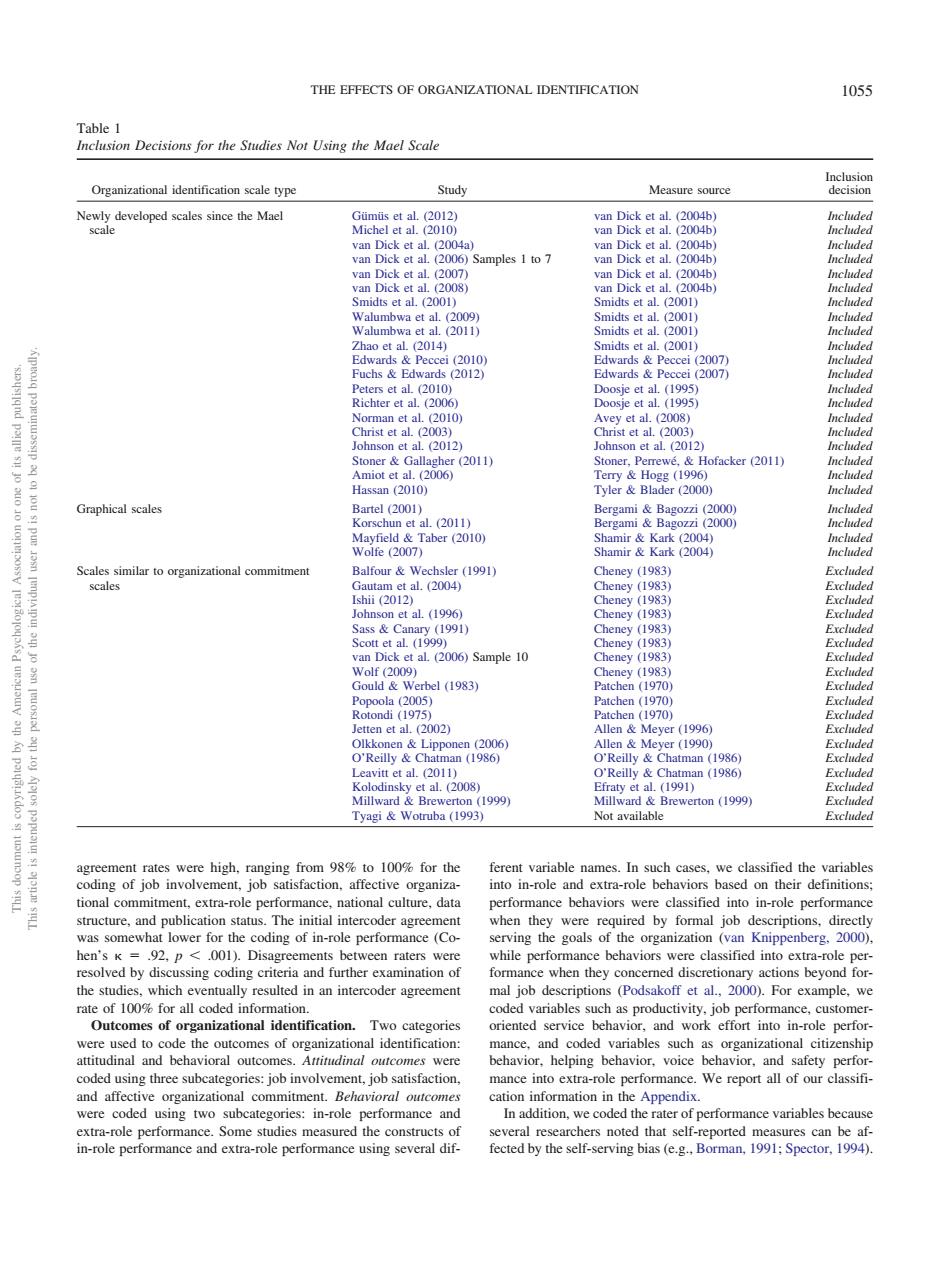正在加载图片...

THE EFFECTS OF ORGANIZATIONAL IDENTIFICATION 105S Table1 Inclusion Decisions for the Studies Not Using the Mael Scale Organizational identification scale type Study Measure sourc Nedeveloped scales ince the Mael Samples I to 7 t201 2007 de L2010) Hofacker (2011 Salesiaiartooganizaionadcoammimean henev (1983 bel (1983) 00 201 Tyagi w ha199399 199 Not a ailab o in-role performanc cture. pt0a2000. hen's 0D1 Disa s were d into extra- ole per the stud ntually resulted in an intercoder agreemen mal iob de mple we oded varia ance.customer es of organizational identificatio nance citize voice chavior.and and affective orga commitment.Beho ral ou Appendix ucts of cal re in-role performance and extra-role performance using several dif- fected by the self-serving bias (e.gBorman.99:Spector,1994).agreement rates were high, ranging from 98% to 100% for the coding of job involvement, job satisfaction, affective organizational commitment, extra-role performance, national culture, data structure, and publication status. The initial intercoder agreement was somewhat lower for the coding of in-role performance (Cohen’s .92, p .001). Disagreements between raters were resolved by discussing coding criteria and further examination of the studies, which eventually resulted in an intercoder agreement rate of 100% for all coded information. Outcomes of organizational identification. Two categories were used to code the outcomes of organizational identification: attitudinal and behavioral outcomes. Attitudinal outcomes were coded using three subcategories: job involvement, job satisfaction, and affective organizational commitment. Behavioral outcomes were coded using two subcategories: in-role performance and extra-role performance. Some studies measured the constructs of in-role performance and extra-role performance using several different variable names. In such cases, we classified the variables into in-role and extra-role behaviors based on their definitions; performance behaviors were classified into in-role performance when they were required by formal job descriptions, directly serving the goals of the organization (van Knippenberg, 2000), while performance behaviors were classified into extra-role performance when they concerned discretionary actions beyond formal job descriptions (Podsakoff et al., 2000). For example, we coded variables such as productivity, job performance, customeroriented service behavior, and work effort into in-role performance, and coded variables such as organizational citizenship behavior, helping behavior, voice behavior, and safety performance into extra-role performance. We report all of our classification information in the Appendix. In addition, we coded the rater of performance variables because several researchers noted that self-reported measures can be affected by the self-serving bias (e.g., Borman, 1991; Spector, 1994). Table 1 Inclusion Decisions for the Studies Not Using the Mael Scale Organizational identification scale type Study Measure source Inclusion decision Newly developed scales since the Mael scale Gümüs et al. (2012) van Dick et al. (2004b) Included Michel et al. (2010) van Dick et al. (2004b) Included van Dick et al. (2004a) van Dick et al. (2004b) Included van Dick et al. (2006) Samples 1 to 7 van Dick et al. (2004b) Included van Dick et al. (2007) van Dick et al. (2004b) Included van Dick et al. (2008) van Dick et al. (2004b) Included Smidts et al. (2001) Smidts et al. (2001) Included Walumbwa et al. (2009) Smidts et al. (2001) Included Walumbwa et al. (2011) Smidts et al. (2001) Included Zhao et al. (2014) Smidts et al. (2001) Included Edwards & Peccei (2010) Edwards & Peccei (2007) Included Fuchs & Edwards (2012) Edwards & Peccei (2007) Included Peters et al. (2010) Doosje et al. (1995) Included Richter et al. (2006) Doosje et al. (1995) Included Norman et al. (2010) Avey et al. (2008) Included Christ et al. (2003) Christ et al. (2003) Included Johnson et al. (2012) Johnson et al. (2012) Included Stoner & Gallagher (2011) Stoner, Perrewé, & Hofacker (2011) Included Amiot et al. (2006) Terry & Hogg (1996) Included Hassan (2010) Tyler & Blader (2000) Included Graphical scales Bartel (2001) Bergami & Bagozzi (2000) Included Korschun et al. (2011) Bergami & Bagozzi (2000) Included Mayfield & Taber (2010) Shamir & Kark (2004) Included Wolfe (2007) Shamir & Kark (2004) Included Scales similar to organizational commitment scales Balfour & Wechsler (1991) Cheney (1983) Excluded Gautam et al. (2004) Cheney (1983) Excluded Ishii (2012) Cheney (1983) Excluded Johnson et al. (1996) Cheney (1983) Excluded Sass & Canary (1991) Cheney (1983) Excluded Scott et al. (1999) Cheney (1983) Excluded van Dick et al. (2006) Sample 10 Cheney (1983) Excluded Wolf (2009) Cheney (1983) Excluded Gould & Werbel (1983) Patchen (1970) Excluded Popoola (2005) Patchen (1970) Excluded Rotondi (1975) Patchen (1970) Excluded Jetten et al. (2002) Allen & Meyer (1996) Excluded Olkkonen & Lipponen (2006) Allen & Meyer (1990) Excluded O’Reilly & Chatman (1986) O’Reilly & Chatman (1986) Excluded Leavitt et al. (2011) O’Reilly & Chatman (1986) Excluded Kolodinsky et al. (2008) Efraty et al. (1991) Excluded Millward & Brewerton (1999) Millward & Brewerton (1999) Excluded Tyagi & Wotruba (1993) Not available Excluded This document is copyrighted by the American Psychological Association or one of its allied publishers. This article is intended solely for the personal use of the individual user and is not to be disseminated broadly. THE EFFECTS OF ORGANIZATIONAL IDENTIFICATION 1055��